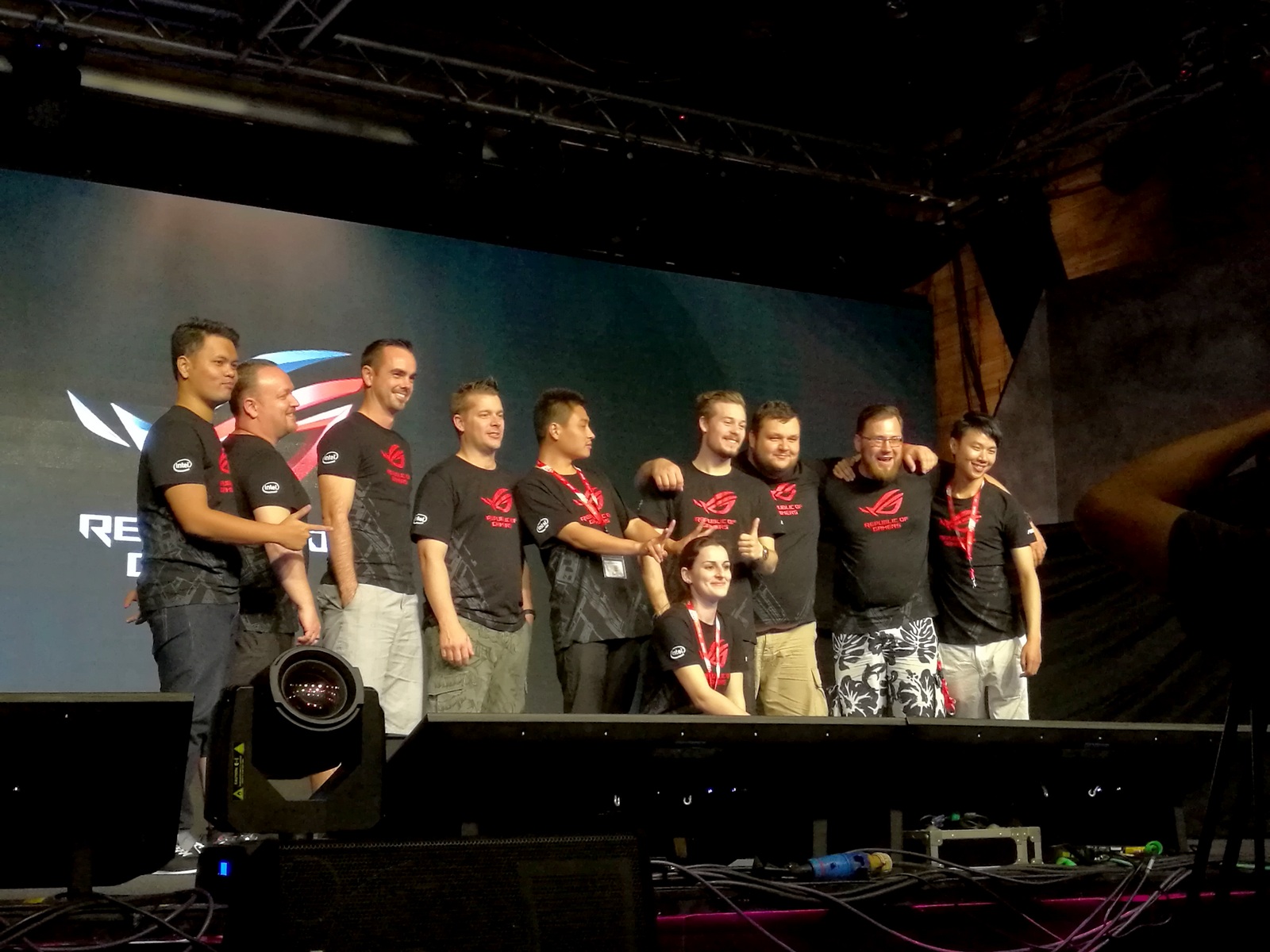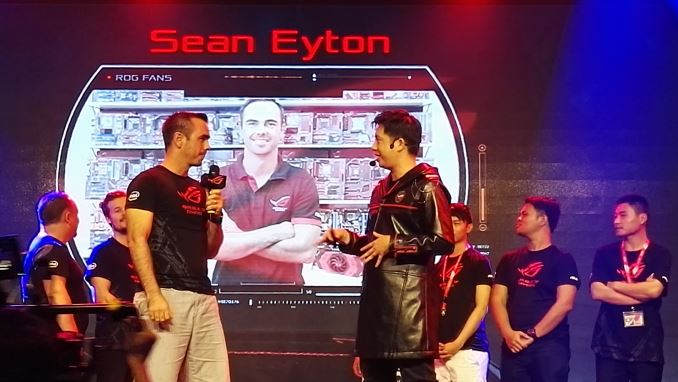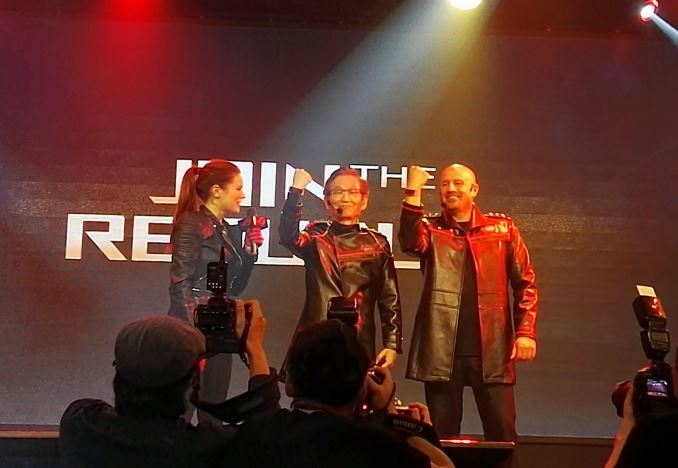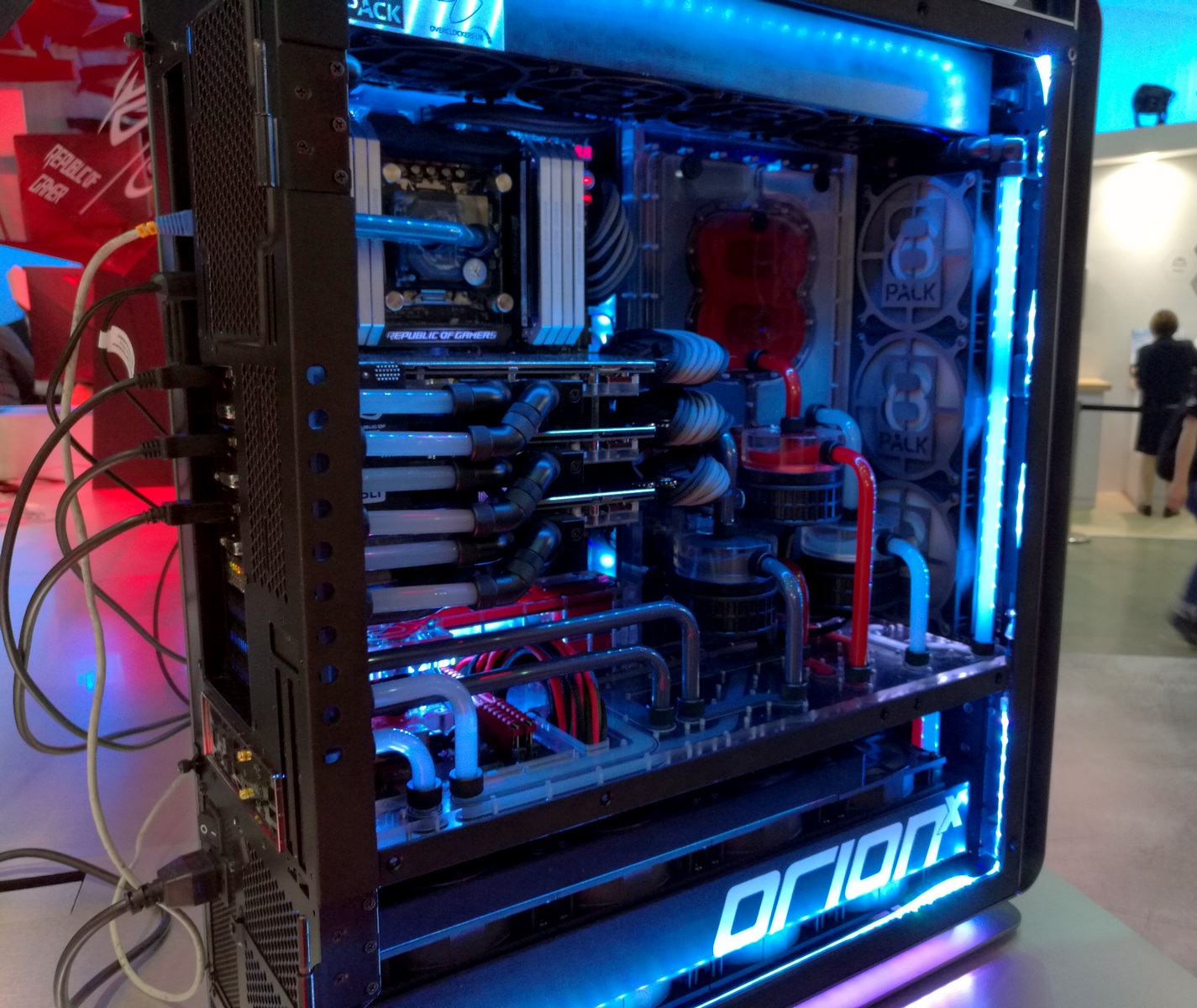ASUS at Computex 2016: The 10 Years of the Republic Of Gamers (ROG) Booth Tour
by Ian Cutress on June 22, 2016 8:00 AM EST
For anyone following our Live Blog coverage at Computex this year, ASUS had two large press events in quick succession in different parts of town. The first focused on the mobile lineup of launches, in an event called Zenvolution (playing off of the Zen line of products) where Jonney Shih played rapid fire with the new Zenbook 3, Transformer 3/Pro 3, ZenFone 3 devices, and a $599 home assistant robot called Zenbo. A few hours later, over the other side of town, was the annual Republic of Gamers event held in a local nightclub where Jonney Shih presented a sequence of 10th-anniversary products. The following day we made a bee-line to the show floor booth before the official opening time and went through a number of the major releases.
Marking 10 Years of ROG
We reported back in January and CES that ASUS was celebrating ten years of the Republic of Gamers brand, marking a now noticeably profitable success for the company and a very well-known fixture for users looking at gaming branded products. At the time, we headed up a round-table with two of AnandTech’s most recent former Senior Motherboard Editors (who both now work at ASUS) to go into detail about why ROG exists, what it means for users, and I also put to them a dozen or so questions from our readers.
However at the time, CES was a relatively minor show for ASUS: as a company, it was decided to cancel the intended press events and make Computex a little more special, as anything announced at CES would have launched after Computex anyway. That led the way for Computex being the primary focus for the announcements this year, not only for the Zen product line of smartphones and notebooks, but also for the Republic of Gamers. We saw the announcement of a mix of 10 Year anniversary products, prototypes, and updates over previous generations of products. ASUS also wanted to make it special, and invited a series of ‘super fans’ to the show as well as a number of gaming teams that ASUS sponsors.
Among the super fans were a few overclockers, one of which is a former team member of mine in the most prominent overclocking leagues, as well as an ROG user who had acquired all (or almost all) of the ROG motherboards that have ever been released, with a total expenditure exceeding $10,000. He also had a few GPUs for good measure.
The ASUS ‘10 Years of ROG’ press event felt somewhat eerie: if someone in attendance had no idea of what ROG was, it felt almost like a cult leader of an army, and sure enough ASUS’ Chairman, Jonney Shih, came out in a knee length custom leather jacket, cap, and the title ‘ROG Commander-in-Chief’. Follow lots of low-frequency bass lines, a laser and smoke show, and technology reveals by ROG Generals, and you might not realize that this is actually just a product launch. When it has one, every brand enjoys a loyal following when users invest their money into that brand or product line, and it was clear that ASUS enjoys extrapolating the ideals of their following to a user army-like status.
Nonetheless, the product announcements were thick, fast, and lacking in just enough detail to force the press to crowd the limited samples on hand on display in the nightclub. At the time when the press event finished, Billy went for a stroll around the new products (as all the other media charged the demonstration area) while I closed up a few emails, but we waited until the following day and was able to browse the ASUS ROG Booth before the official opening time and before the mêlée of other press descended on what felt like the biggest booth at the show.
We saw a number of new products, and a big part of the show in general was the attention to detail by users who modify cases (or modders for short) that companies commission special show builds for. ASUS had a number of these on display as well, ranging from elegant to crazy. This includes custom system-integrator and retailer designed systems, such as the newest tri-loop cooled 8Pack designed system claiming to be the fastest overclocked system you can buy in the world. We interviewed 8Pack at an OverclockersUK event a couple of years ago, which you can read here.
So, in no particular order…
















43 Comments
View All Comments
Ian Cutress - Thursday, June 23, 2016 - link
It's an MSword issue when you (sometimes) insert a hyperlink. Should be fixed.Soundgardener - Sunday, June 26, 2016 - link
No; it's a technical publication issue when you forego proof-readers / copyeditors. Other examples:we waited until the following day and was able to browse the ASUS ROG Booth (we WERE not we was)
and they seem willing to be prepared to pay for it (willing / prepared: pick one, delete the other ;)
Other features such as color accuracy are also lauded by the professional community as well. (also / as well: again, only one needed...)
better color reproducibility (better colour reproduction, better colour gamut, or better colour...)
alphasquadron - Wednesday, June 22, 2016 - link
For the 240hz monitor, a good way to tell if the human eye cannot tell a difference is to test it out with professional gamers (preferably fast twitch shooters). They should be able to tell you if there is a difference or do a blind test with them. I won't listen to any more regular idiots who for the previous generation said the eye cannot tell the difference between 60hz and 120hz.Lolimaster - Wednesday, June 22, 2016 - link
The main difference people should be noticing is not about "gaming" but the thing that it reduces further more the innate flaw of the LCD/OLED sample and hold way of delivering frames vs the constantly refresh nature of CRT.OLED should starting to be called true CRT successor when every panel goes at 240Hz.
alphasquadron - Wednesday, June 22, 2016 - link
Thought anything over a 100hz had a better refresh rate than CRTs, but then again not sure.Lolimaster - Wednesday, June 22, 2016 - link
Frame time (sample and hold tech):60hz 16.66ms
120hz 8.33ms
240Hz 4.16ms
Technically you'll need about 960Hz on LCD's to achieve CRT levels of smoothness (lightboost is pretty close).
alphasquadron - Wednesday, June 22, 2016 - link
That sucks because I don't see us reaching hardware to drive 960Hz anytime soon. We just got the hardware to drive 144hz at 1080p smoothly.Gastec - Wednesday, August 31, 2016 - link
Considering that LCD monitors entered "mainstream" in 2003-2004 and that good quality 144Hz+ monitors of all resolutions are still prohibitively expensive for the average Joe, I would make a quick estimate that 960 Hz and it's driving hardware would theoretically reach our mortal realms in about 160 years.Midwayman - Thursday, June 23, 2016 - link
There are studies to say that 240hz should be usable. However there are two things. Imagine persistence is more important and they didn't explicitly state ULMB support or what refresh range it works at. Second is there is really a point of diminishing returns for refresh anyways. With a 144hz monitor the difference between 60hz and 100hz is readily apparent. Going from 100 to 144hz less so. I imagine the jump to 240hz even less important.Bragabondio - Wednesday, June 22, 2016 - link
Can anybody explain me why for God's sake there millions of updated LGA 2011-v3 motherboards but only in ATX size!?! I was patiently waiting to build a new Broadwell E PC with micro ATX or even mini ITX board and there is not a single micro ATX that has all the new features of their big brother (some don't have USB 3.1 other have the M.2 in the older PCI 2 format - not much faster than the SATA 3 etc.) Even going for z170 ( can't believe I will be upgrading to 4 core CPU after 6 years of 4 core CPU - core i7 870!) and there are just a few micro ATX z170 boards with all the new features.I am not going back to gigantic ATX case - thank you very much, so I am left with the choice of either not upgrading (I gave my old PC to my mom so currently I use MS Surface pro with a dock that works well for office work not so much for gaming) , wait for ZEN, buy a laptop that supports external video card dock (laptop + dock would probably take the same space and would have zero upgradability - except for the video card) or cave up and get core i7 6700k.
So I don't understand why manufacturers don't want my money?